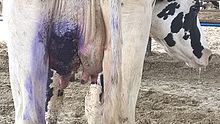
Back التهاب الثدي عند الحيوانات Arabic Mastitis (Haustiere) German Mastitis (animales domésticos) Spanish Mastiit Estonian Mammite (animaux domestiques) French Maistíteas buaibheach Irish थनैला रोग Hindi Júgurbólga Icelandic അകിടുവീക്കം Malayalam थुनेलो Nepali


Bovine mastitis is the persistent, inflammatory reaction of the udder tissue due to physical trauma or microorganisms infections. Mastitis, a potentially fatal mammary gland infection, is the most common disease in dairy cattle in the United States and worldwide. It is also the most costly disease to the dairy industry.[1] Milk from cows suffering from mastitis has an increased somatic cell count. Prevention and control of mastitis requires consistency in sanitizing the cow barn facilities, proper milking procedure and segregation of infected animals. Treatment of the disease is carried out by penicillin injection in combination with sulphar drug.
- ^ Department of Animal Science. "Mastitis in Dairy Cows" (PDF). MacDonald Campus of McGill University. Archived from the original (PDF) on July 8, 2003. Retrieved 4 February 2010.
© MMXXIII Rich X Search. We shall prevail. All rights reserved. Rich X Search